1.02.2019
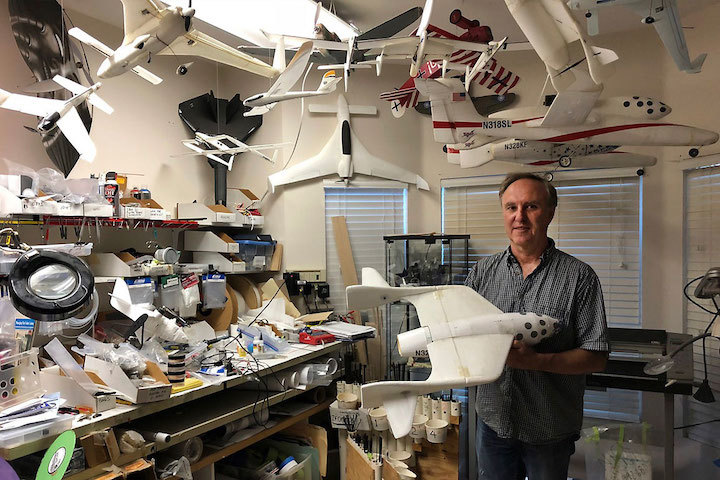
Dan Kreigh, a senior structural engineer at Scaled Composites, displays his scale model of SpaceShipOne. | Daniel Housman
“How do you keep a spaceship simple?” Dan Kreigh rhetorically asks several dozen attendees of “Plane Crazy Saturday,” a monthly event for aviation fans held at the Mojave Air & Space Port (MASP). The group had convened on a sweltering August afternoon in the MASP’s boardroom to discuss aircraft aesthetics, tech and design up close. Continuing with his presentation, Kreigh explains how the question was first posed twenty years ago by his now retired boss Burt Rutan — the maverick designer and founder of Scaled Composites who is known throughout the world for his radically unorthodox aerospace designs along with his signature mutton chop sideburns inspired by none other than the 1970s-era Elvis.
A soft-spoken man with a gentle easy laugh, Kreigh holds up the model of SpaceShipOne (SS1), one of Scaled’s finest achievements. The thirty-year company veteran built the scale model of the much-lauded spacecraft while working as lead structural engineer under Rutan’s tutelage. Rutan hadn’t originally asked Kreigh to build the model of SS1 but Kreigh decided to step up to his challenge. Besides, he wanted to see if Rutan’s inventive proposed re-entry system could work in miniature. So he went ahead with designing and assembling his SS1 model but, for a time, kept it under wraps.
Kreigh demonstrates to “Plane Crazy” onlookers the SS1’s signature engineering breakthrough: after flying in suborbital elevation at 100 KM (62 miles), upon re-entry the rear half of the wings “feather” as the twin-tail dramatically folds upwards seventy degrees while the plane elegantly descends back into Earth’s atmosphere. This engineering feat not only slows the plane’s re-entry speed but also increases drag without creating tremendous heat on the plane’s body thus producing a shuttlecock effect that stabilizes the aircraft.
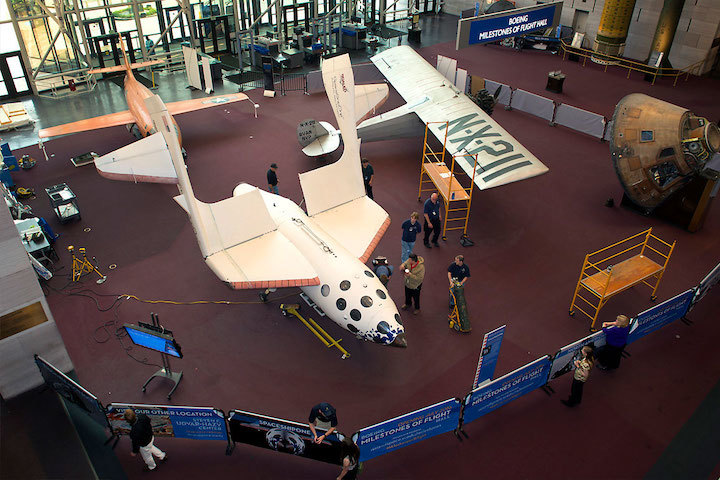
SpaceShipOne with its iconic feathering deployed at the Smithsonian National Air and Space Museum. | Mark Avino
During SS1’s fast-paced and stress-riddled development stage in the early 2000s, Kreigh describes a pivotal moment when he sensed that Burt was nervous — a trait that Rutan rarely exhibited in front of his team. SS1 engineers had conducted a successful glide test but not a powered flight so, understandably, the test pilots had a right to question the integrity of Rutan’s design to operate as planned.[i] After all, simple design flaws can mean death for a test pilot. Aware of this intense scrutiny, Kreigh decided that it was time to unveil his scale model to set the pilots’ and engineers’ minds at ease: “Whatever dimension you shrink it down to, it should still, if you’ve gotten it right, fly in a similar way.”
When Burt first viewed Kreigh’s model he, too, questioned whether it would work. On its first launch, Kreigh’s model performed the feather system functionality perfectly, thanks to Dan’s radio control of the maneuver. Burt excitedly gathered the pilots and made Dan repeat the flight test out on the runway. “So yeah, I fly it again, run the motor, fly it up high and turn the motor off — it’s a glider — and then activate the feather, which comes down and then the plane recovers and then lands.” Burt was ecstatic, telling the test pilots, “See I told you it would work!” This would be one of Kreigh’s best days of his career. Dan just says, “There were a lot of days like that, working at Scaled.”
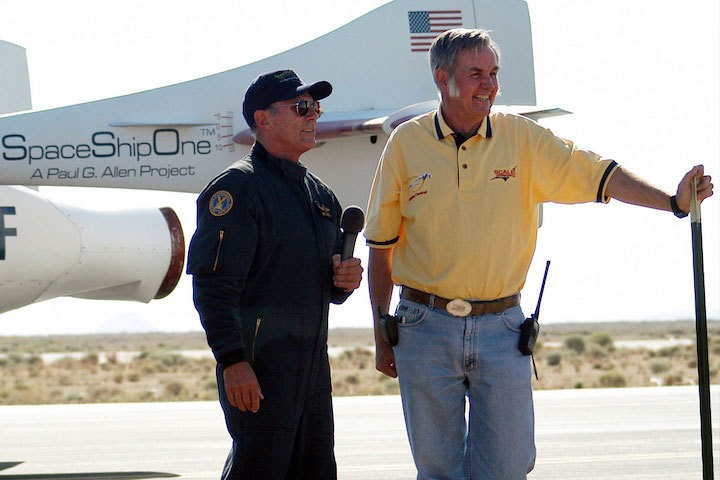
SpaceShipOne astronaut Mike Melvill (left) with Burt Rutan (right) speak to media after the first SS1 flight. | D. Ramey Logan/Wikipedia. (CC BY-SA 3.0)
On June 21, 2004, Mike Melvill[ii] piloted SS1 to the Karman Line high above the Mojave Desert after separating from its White Knight mothership. As SS1’s hybrid rocket-powered engine engaged, Melvill was propelled skyward, and not without difficulty, to 328,491 feet.[iii] The entire flight lasted a total of 24 minutes, three of which were flown in the weightless realm just beyond Earth’s atmosphere. This air-launched spacecraft was the first successful suborbital spaceflight to be privately funded, designed and built by civilians.[iv] On that day, Rutan and company made history and an astronaut out of Melvill — as Burt’s famous test pilot brother, Dick Rutan likes to note. Scaled’s “reusable” spacecraft, launched from a small, unassuming airport in Mojave, California, would set three flight world records and shift the trajectory of this town from aeronautics into astronautics overnight.[v]
Even before SS1, Burt Rutan was highly regarded within the professional avionics community for his innovative aircraft designs. He was known for stripping away anything non-essential while managing structural stress and weight with breakthrough composite materials formed into singular shapes while managing to retain functional flourishes. Still, with forty plus cutting-edge aircraft designs under his belt, Burt Rutan was largely unknown to the outside world. Shortly after he and his team claimed the $10 million Ansari X-Prize in October 2004, his celebrity, and the popularity of the company he built, soared. The stakes for privately funded astronautics were now skyrocketing. Scaled’s success confirmed that relatively affordable commercial space tourism was indeed on the horizon — space travel was no longer the exclusive domain of NASA, military and other federally funded government programs.
By the mid-2000s, Scaled’s success story would usher in a slew of private, commercially driven astronautics companies to Mojave including Stratolaunch Systems, Virgin Galactic, Masten Space Systems and Interorbital Space Systems, all of whom collectively foresee a massive market in commercial civilian spaceflight occurring in the 2020s.
Without the XPRIZE, this extraordinary feat may never have occurred. When engineering entrepreneur Peter Diamandis announced the global competition in 1996, federally funded aerospace research had become largely dormant with the Space Shuttle nearing the end of its program. The haunting memory of the 1986 Challenger disaster and, some years later, the 2003 Columbia explosion, contributed to lack of public enthusiasm for the government funded space program. By the mid-2000s, aerospace research and development had dwindled significantly.
With NASA’s shrinking budgets and future research encumbered by endless red tape, Diamandis foresaw the future of space exploration as dynamic public-private partnerships. Although Diamandis hadn’t secured the actual funding that would be required, he “threw down a gauntlet” attracting 26 fiercely competitive international teams to the table. To claim the $10 million purse dangled in front them, one team would need to design an experimental, three-passenger spacecraft that could travel beyond 100 KM, survive atmospheric re-entry and have the potential to be reused for future suborbital spaceflights — all built and tested by private citizens.
Diamandis envisioned that the XPRIZE would herald a new era of commercial space exploration and tourism that would, in turn, boldly propel the once exclusively government funded aerospace industry to seriously consider civilian-led space travel. The only setback was the fact that Diamandis didn’t have money to guarantee the prize’s hefty purse.
As is often the case with big innovations, dreams come first and remain grounded without proper financing. At the start, Diamandis, who is both an engineer and a physician, lacked personal fortune or a wealthy sponsor to pledge the $10 million-dollar prize. After searching high and low for eight years, Diamandis eventually found support from two Iranian-American entrepreneurs, Anousheh Ansari and her brother-in-law Amir Ansari, who became sponsors of the first XPRIZE in May of 2004.[vi] Anousheh, a computer engineer, became the first Iranian in space when she traveled to the International Space Station as a privately funded astronaut on September 18, 2006.
Inspired by Diamandis’ challenge, Rutan and his team began looking for serious investors to provide the huge sums of money necessary to finance the years of research and development that were required to design, build and test such a spacecraft. After pitching to a number of corporations and wealthy individuals (including British billionaire Sir Richard Branson), late Microsoft billionaire Paul Allen enthusiastically came onboard with $25 million.
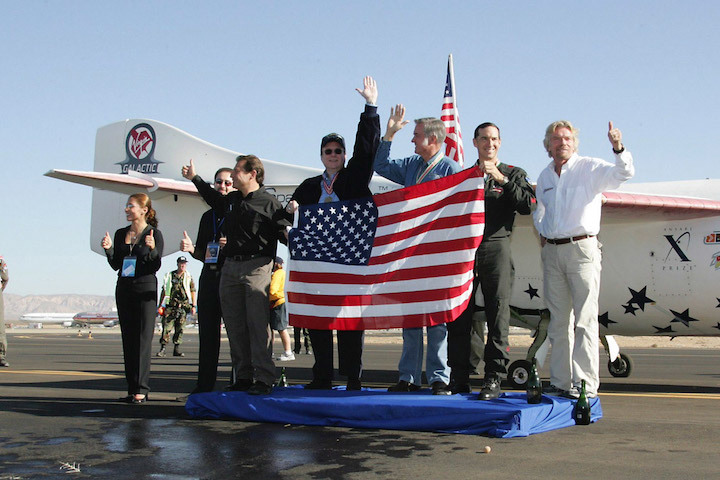
Celebrating the 2004 Ansari XPRIZE: Anousheh Ansari, [unidentified], Peter Diamandis, Paul Allen, Burt Rutan, Brian Binnie (pilot) and Richard Branson are pictured from left to right. | Courtesy of XPRIZE Foundation
By early fall 2004, after eight years of development, Rutan and the Scaled team completed the two required flights within a week of each other that resulted in the team taking the Ansari XPRIZE. Rutan would later distribute some of the prize money as bonuses for his team. Branson, having missed his earlier opportunity, swooped in and acquired the technology behind SS1 and its White Knight carrier forming Virgin Galactic along with The Spaceship Company in partnership with Scaled Composites. Allen would launch Stratolaunch Systems, also partnering with Scaled.
Rutan/Allen/Branson’s achievements were boosted in a few short years by breakthroughs from Elon Musk’s SpaceX, who developed the first liquid-fueled rocket that launched a commercial satellite into orbit on July 2009 and Jeff Bezos’ Blue Origin, which has successfully demonstrated thrusters to achieve soft landings of both space capsules and rocket boosters. The race for reliably reusable launchers is driving the scalability and financial sustainability of the industry. Ergo, this quartet of billionaires (Allen/Bezos/Branson/Musk) has helped drive the aerospace industry back into the spotlight and into the public imagination.
Scaled’s XPRIZE accomplishment and the global attention it brought to the region was also a win for the town of Mojave — where it all began. “They didn’t do it from Vandenberg, they didn’t do it from California City; they did it from Mojave,” says Stu Witt, the former general manager of the MASP whose motto is “Imagination Flies Here.”
Witt continues, “Before the XPRIZE, Scaled had less than fifty people. NASA had 17,000 employees and 106,000 contractors! But if you’re in a profession where just your opinion can lead to litigation, the amount of insurance you need to carry is ridiculous. Whereas we had a saying, ‘Flight testing should be like sex — behind closed doors and with the minimum required participants’,” wryly states Witt. Karina Drees, MASP’s current general manager, puts it another way: “When it comes t o testing, companies doing R&D here, we like to say we start at ‘yes’ and it takes a lot to get to a ‘no.’ We don’t want to give our customers a lot of hurdles and red tape.”
“That type of attitude is pervasive in the high desert,” says Dick Rutan, who famously co-piloted the Rutan Voyager aircraft, designed by his brother Burt, in 1986. Reflecting on the storied history of test flight in the area Rutan comments, “I look across the way at these dry lake beds — this is aviation’s hallowed ground. For all the airplanes that you enjoy — the safety and efficiency of them — there’s a lot of guys that worked and died to give us that. Mojave is an incredible place.”
Burt and Dick Rutan were raised in the agricultural community of Dinuba located in California’s San Joaquin Valley. Dick, the elder brother, received his car and solo pilot license on his sixteenth birthday. By nineteen, he had joined the Air Force, training as a fighter pilot. Burt, described by Dick as “the consummate geek”, would graduate from California Polytechnic in 1965, with a degree in aeronautical engineering. Not long after graduation, Burt became a flight test engineer at Edwards Air Force Base, until 1972, when he left for a short stint in Kansas with inventive aircraft designer Jim Bede. At the invitation of Mojave’s East Kern Airport District manager Dan Sabovich in 1974, Burt returned to the high desert to set up shop, encouraged by its wide-open spaces, cheap real estate and lack of prying eyes.
Burt brought with him a number of prototypes for planes he’d been building up to now in his garage, first the Rutan VariViggen (loosely inspired by a Swedish fighter plane—the Saab 37 Viggen), and later the Rutan VariEze and Rutan Long-EZ. Understandably, the mid-1970s are considered the height of the home-built, high-performance aircraft era. Rutan’s unique flair for design and engineering, including his signature breakthrough using inventive composite materials and other ingenious fabrication innovations, captivated the industry. His “open source” business philosophy challenged aviation designers too, starting with the VariViggen, Rutan publicly shared the designs and assembly instructions, selling aircraft kits for hobbyists to build at home. As Rutan’s reputation grew his protean creativity multiplied. “Research should be defined as doing something where half the people think it’s impossible and half of them think maybe that will work,” Burt commented. “Any true breakthrough is one you can go back and find a time-period where the consensus was, ‘well that’s nonsense.’ A true creative researcher has to have confidence in nonsense.”
Dan Kreigh was one of those aspiring engineers who bought one of Burt’s experimental aircraft design guides while attending college. He discusses Burt’s genius, both intentional and accidental: “So when he [Burt Rutan] starts Scaled Composites, soon he needs more engineers and designers. But by having introduced them to the Long-EZ and VariEze (I think he sold 11,000 booklets) there were like, 2,000 of these designs out there flying so he had a whole army of people out there that already had built his airplanes [and in turn] know his personal philosophy and structural philosophy.” Kreigh says Burt is “a natural teacher. He just loves educating people, he doesn’t worry about proprietariness, because he’s always onto the next thing.”
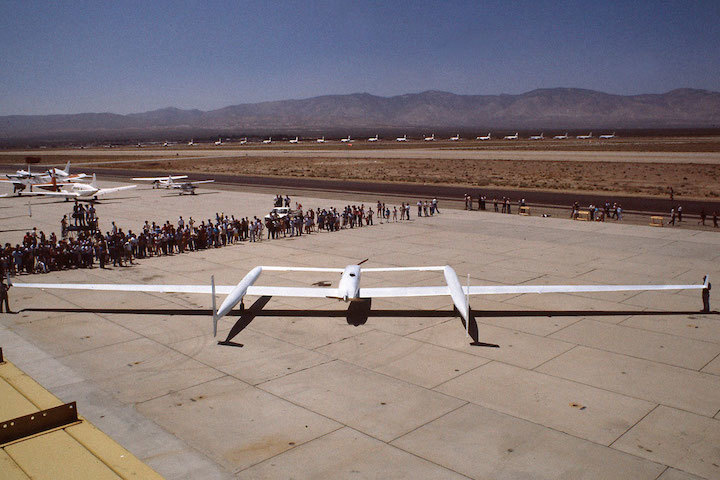
The Rutan Voyager on the MASP's runway. | Courtesy of the Smithsonian
But if Rutan grew to prominence for his custom kit planes, the Rutan Model 76 Voyager thrust him into a new level of national attention after the Voyager, co-piloted by his brother Dick and Jeana Yeager, became the first aircraft to fly around the world without stopping or refueling on December 23, 1986. This multi-record-breaking flight covering 26,358 miles and took nine days, three minutes and 44 seconds to complete. In order to do so, Rutan and Yeager flew Voyager painfully slowly — at an average ground speed of 116 mph in order to maintain the utmost fuel efficiency. As the days passed and the craft’s fuel load lightened, fuel efficiency increased from a mere 9 mpg at the start to nearly 50 mpg by the end of the flight. Unaware of the international media attention their flight was generating, due to sheer physical and mental exhaustion, the duo completed their flight, returning back to Edwards Air Base’s Rodgers Dry Lake runway to a reception of over 50,000 eager spectators. A few days later, President Reagan awarded Jeana, Burt and Dick the Presidential Medal of Honor.
Rutan would later comment how he had worried that Air Force tower personnel would refuse to accommodate Voyager’s landing thus invalidating the flight’s anticipated world record[vii] because he didn’t remember gaining the proper clearance to do so before the flight had commenced. When he humbly asked the on-duty flight controller to do so, the gentleman replied back, “Sir, this is Edwards tower. Sir, we’ve canceled flying today and we’re all waiting for your return.”
Without question, both Rutan brothers are inspiring figures.[viii] As a charismatic industry leader, known for the extreme loyalty of his staff, Burt retained control of his increasingly valuable company despite Northrop Grumman Corporation acquiring a 40 percent stake in the 1980s before they fully bought it out in 2007 as Burt transitioned into semi-retirement. And while Burt is known as the maverick Renaissance inventor, Dick compliments him as the brazen, unapologetic test pilot with intuitive instincts honed from years with the Air Force. Dick flew 325 missions in Vietnam (105 of those flying the F-100Super Sabre for the elite, high risk MISTYs) earning him a slew of military honors including a Silver Star and a Purple Heart before he retired as a lieutenant colonel in 1978.[ix]
To this day Dick remains the tough-talking ex-combat pilot. He cops to needing a thrill whenever he’s been bored and is known to disappear for days into the desolate Mojave backcountry on his dirt bike. Now 80 years old, Dick still resides in Mojave and regularly has breakfast at the MASP’s Voyager diner, open to the general public. Dick loves to recall the details of the record-breaking flight but is careful to equally emphasize the grueling process along with the level of disbelief he, Burt, Jeana, crew chief Bruce Evans and the dozens of volunteers had to endure for five and a half years while the aircraft was developed, built and tested. “Up until we started, I had not even a clue that an un-refueled flight around the world was possible. The absolute record was halfway around the world and that was by a goddamn B-52. And who in the hell are we? We didn’t have two nickels to rub together back in 1980.”
He still remembers the single-minded devotion it took and knew the experience would be unrepeatable. “For five and a half years, I didn’t go to a movie or out to dinner — [I did] nothing for myself. This was Burt’s design and vision but the three of us [Burt, Dick and Jeanna] laid or checked every single strand of carbon fiber in that whole thing. We didn’t have any seatbelts, no crash survivability — any little turbulence the first four days, we were going to die.” In fact, the flight was nearly cancelled when the wing tips scraped across the runway during takeoff, having resulted from the immense weight of the fuel that had been ingeniously stored within the wings and the other sections of the aircraft. Dick was far too driven to abort the flight and quickly figured out how to shed the winglets without thinking twice.
Without much prodding, Dick openly discusses his brushes with near death including his last combat flight over North Vietnam when he had to eject from his burning F-100 after losing his co-pilot to enemy ground fire; or the time he had to bail out over England due to engine failure on a Cold War mission. He laughs ruefully at his misguided attempts while competing in global hot-air balloon races — the majority near-disasters. These stories and many umpteen others are included in Rutan’s upcoming memoir entitled “The Next Five Minutes” as in, Dick explains, “when my balloon blew up, when I got shot down, I remember reaching for the ejection handle and thinking, “I wonder what the next five minutes is going to be like?” As if to drive home that thought, while reminiscing about his experience as a test pilot during his interview, Dick mordantly quips to Dan Kreigh, “Melvill and I, can you believe we’re both still fucking alive?”
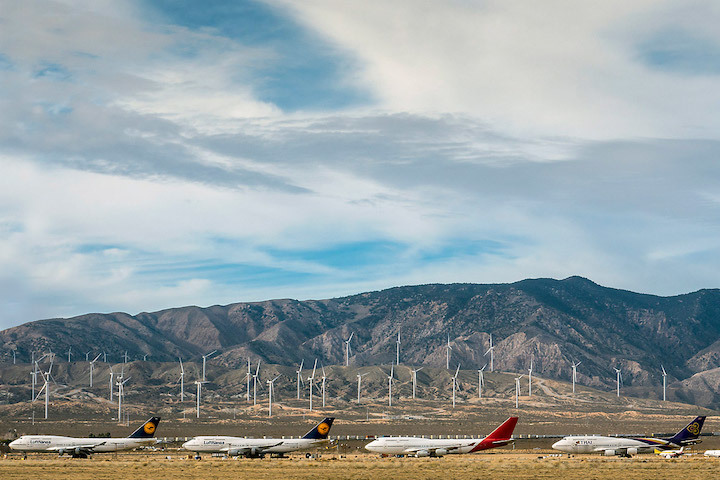
A view of Mojave's Boneyard taken from the runway of the Mojave Air & Space Port. | Kim Stringfellow
The town of Mojave (pop. 4,238) is located about 95 miles north of Los Angeles at the base of the Tehachapi Mountains in eastern Kern County where State Routes 14 and 58 converge. Travelers are likely to notice the acres of churning wind turbines punctuating the Tehachapi’s fawn-colored foothills. The wind farm, considered the second largest in the state and third largest in the world, is comprised of close to 5,000 turbines that collectively produce about 3,236 megawatts of electricity.[x]
Also at this highway juncture, more observant motorists may catch a glimpse of Mojave’s “Boneyard” where abandoned commercial jetliners are cannibalized for parts or simply laid to rest. Others may notice several massive aircraft hangars looming in the distance to the east. If the driver fails to notice these sights, upon entering Mojave via SR 14 (officially known as the “Aerospace Highway”) the town’s signature industries will clearly come into view. “WELCOME TO MOJAVE. Home of SpaceShipOne,” states two billboards picturing the famous spacecraft amid towering wind turbines framed by the rocket’s graceful, arched contrail that bookmarks the town’s north and south entrances.
Mojave’s proximity to the aerospace industrial hubs of Rosamond, Lancaster and Palmdale in Antelope Valley are vital for its continued economic growth. Edwards Air Force Base, strategically positioned to make use of Rodgers Dry Lake — the massive endorheic playa that is located east of the town, has witnessed Chuck Yeager breaking the sound barrier in the Bell X-1 plus numerous space shuttle landings.
As the motorist continues to move through Mojave’s main gauntlet of fast food joints, roadside motels and gas stations along SR14 they are likely to encounter a freight train burdened with shipping containers lumbering past them on the Union Pacific tracks. The town itself is no-frills, providing services for truckers and motor travelers heading anywhere but here. But, for those who care to listen, the low rumbling of the train provides a sonic portal to Mojave’s historic past.
Originally founded in 1876 by the Southern Pacific, Mojave became the end of the line for the famous twenty-mule team outfits that traveled the 165-mile route from the Harmony Borax Works in Death Valley from 1884 to 1889. The borax was then shipped by rail to Long Beach for sea transport beyond. Later, at the turn of the 20th century, Mojave would serve as the desert headquarters for the construction of the Los Angeles Aqueduct and has remained a vital rail transport route into the 21st century.
Extraction industries have always had a strong presence in this region and can be observed in the discarded mining equipment and abandoned shafts that dot the landscape. In 1935, Kern County built the Mojave Airport to serve the area’s gold and silver mines. This remote desert airport featured two dirt runways (one oiled) but lacked aircraft fueling and repair services. It is interesting to note that the Golden Queen Mine, located five miles south of town, is one of California’s few actively producing, privately owned gold mines. A Canadian outfit runs this 24/7 open-pit heap leach operation at nearby Soledad Mountain.
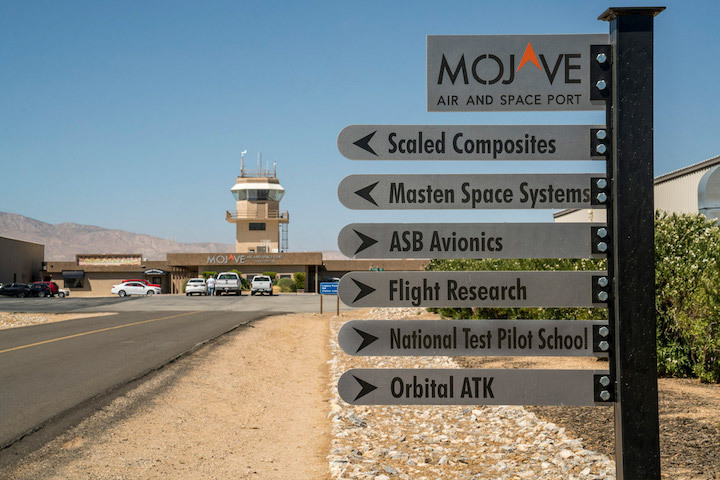
Numerous aerospace companies work out of the Mojave Air & Space Port. | Kim Stringfellow
In 1941, airport improvements were made including the addition of two 4,500’ x 150’ asphalt runways. By the beginning of WWII, the airport was quickly transferred to the U.S. Marine Corps (USMC) and further improvements were made. The Marine Air Station became the training and auxiliary base for USMC pilots, while the Air Force developed the nearby Muroc Army Air Field that was later renamed Edwards Air Force Base in 1949. Alongside the military operations, regional pilots used the airport for gliders, and single and dual-engine planes. Tinkerers, collectors and hobbyist pilots came to enjoy the freedom and wide-open spaces along with relative lack of dust compared to the other regional flight zones. Mojave quickly became an aerophile’s paradise and plane culture quickly evolved.
But like almost any town that loses a military base, Mojave was bound for adjustments when the USMC left for good in 1961. Although civilian consultants continued to work in the area, most families economically tied to the military left the area to relocate in nearby Antelope Valley. The town seemed doomed to fade until rancher and aviator Dan Sabovich took over the vacated airport from the county in 1969 to hold plane races and, by 1972, the East Kern Airport District (EKAD) had formed.
Yet, certainly on the surface, Mojave town seems an unlikely place for such technological advances to be born. The outwardly unadorned facilities at the 3,300-acre Mojave Air & Space Port (MASP) house research labs, offices, a two-mile-long runway along with nearly 100 airplane hangars with some concealing secret experimental aircraft prototypes against the backdrop of the Boneyard.[xi]Less than a half mile away is the largest hangar ever built for the biggest airplane ever designed—the Stratolaunch’s carrier aircraft, which recently completed its first high-speed runway test, but has not yet flown.
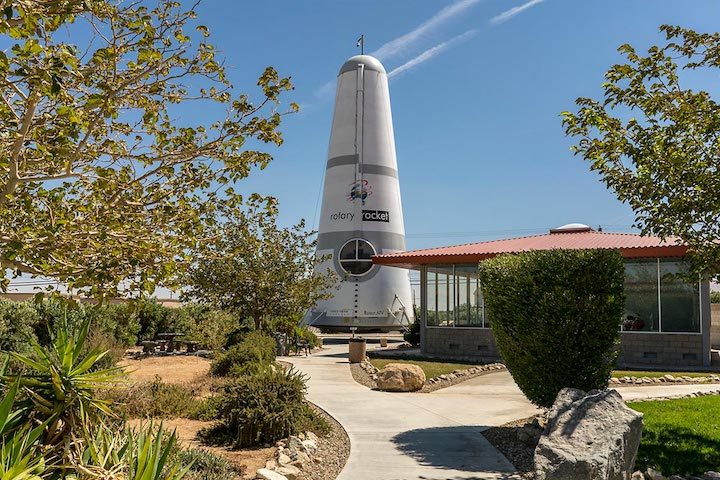
Near MASP sits a mascot of sorts, the now-defunct Rotary Rocket Company’s Roton ATV, a reusable, cone-shaped, vertical launch manned spacecraft. The atmospheric test vehicle raised considerable investment interest early on but, after three hover flights in 1999, became a 63-foot monument to the industry’s inevitable false starts and failures.
On any given day, you might see either the Scaled Composites-designed White Knight Two or SpaceShipTwo — the swan-white mothership or its space-bound rocket — arcing gracefully in the skies above you, being tested by their owner, Virgin Galactic. And finally, if you look lower to the ground, you’ll see a number of plaques for test pilots who’ve died on the job over the last several decades. “The rule of thumb around here,” says Scaled pilot and engineer Zach Reeder, “is you lose about one friend per year.”
The MASP is run as an enterprise zone but it continues to be county-owned and does not receive federal funding. All revenue comes from ground and building leases along with airport fuel sales. MASP receives some infrastructure grants from the Federal Aviation Administration (FAA) periodically that they apply only to taxiway and runway improvements. In 2018, however, of $770.8 million in federal airport infrastructure grants (the third allotment of the total $3.18 billion in Airport Improvement Program (AIP) funding), the Port received just a $1.05 million award to extend a taxiway. Why? There is a law on the books that limits their borrowing to half a million dollars. The MASP Board has tried and failed to get that changed at the government level but as Drees notes, “I can’t borrow much money. I have customers that need an additional facility and I can’t grow fast enough.” But that kind of neglect has its upsides. One of nine “special district” airports within the state of California, the MASP has a five-member Board, elected by the public, and for the most part can engage in significant self-rule.
A common sentiment you hear around town is that the state government has ignored its aviation and aerospace industry because some state legislators fail to distinguish it from the military sector. But others say that federal eyes are watching keenly to see how the industry can expand, address challenges and execute a vision. Though geographically remote, MASP is still a prime proving ground. Drees feels that what happens at Mojave in the next five years will have a major impact on the national and global future of commercial space, UAVs[xii] and short-range flying transport for the masses.
But while Mojave has become the little town that is launching the new era in commercial aerospace, its schools, community spaces and general infrastructure are in desperate need of restoration if the town is to be a more thriving, livable place.
It is estimated that of the 2,500 workers employed by the various aerospace companies housed at MASP, less than one quarter live in Mojave, instead choosing to commute from between 15 and 50 miles away. Many of the town’s remaining residents live near or below the poverty line in dilapidated housing owned by absentee landlords much like other Mojave Desert towns of similar size. As a town formerly economically dependent on the railroad, extractive industries or military, multiple factors have contributed to Mojave’s slow demise. For instance, SR 58 used to go through the center of town but a bypass extension completed in 2004 allows travelers and truck drivers to skirt Mojave’s town center and businesses entirely.
But Mojave’s lack of quality residential housing seems to be the real issue hampering Mojave’s revitalization. Drees, along with George Whitesides, CEO of Virgin Galactic, spoke in various ways about how new housing is the first prerequisite for any meaningful improvements to come to the town. It sounds simple but, unfortunately, it’s not.
For one thing, the town has only a few development zones where new construction is allowed. It comes as no surprise that clear flight paths must be maintained, both for safety, and to retain the companies who pay rent here for Mojave’s famously open skies. Secondly, the area most open to development is situated within a flood plain requiring extra insurance — so there is very little land within town limits available to develop.
Drees, an immensely popular figure in town for her astute stewardship of the MASP and whom no one could accuse of not “doing her part” for the town, admits that when she has a meeting with a new hire she advises most of them not to live in Mojave. She’s seen people try to settle in Mojave, who gave up after a year or two, only to leave their jobs and the region altogether. “The important thing to me is that they stay in their job not necessarily where they bed down at night.”
A Scaled employee who did decide to reside in Mojave is Zachary Reeder, a boyishly charming late thirty-year old, hailing from “the boonies of East Texas.” Growing up in the 1980s, Zach eagerly watched the landing of the Voyager flight as a young boy. He recognizes how this watershed event forever altered his career trajectory. Zach later attended Texas A&M where he majored in flight engineering in the shadow of his father. Six days after graduation, Reeder quickly headed west to Mojave where he promptly landed a position as Scaled’s 120th employee.
Calm, energetic and thoughtful, Reeder rapidly rose to become one of Scaled’s top-tier test pilots over the thirteen years he has worked there. Reeder is part of the Stratolaunch flight crew and leads the wing design team. Now considered a “company statesman”, Zach provides mentorship and guidance for the younger group of engineers and test pilots that are coming on board at Scaled.
Reeder acknowledges how the Rutan brothers served as instrumental figures and values his personal relationship with both men. “Dick is a real good friend, but every time I talk to him it’s just an affirmation of what I realized as a kid; ‘Oh you don’t have to get a boring job and move to the suburbs’.” He goes on to state, “You get to know someone and take their presence for granted, but the fact that we’re buddies and we’ve flown together is a validation of why he was so inspirational to me as a kid.” Burt, too, phones Zach once a month to check in.
Of the 600 Scaled employees, Reeder comments that “I would say probably less than 50 live in Mojave. Only a couple of the engineers live here but most of the fabricators that live here [also] grew up here. Almost everyone lives somewhere else, which I philosophically find really inconsistent and that’s part of the reason we tough it out here.”
Rather than moving to nearby Tehachapi or Lancaster, Zach and his wife purchased an historic adobe church in town that they’ve been slowly fixing up. Having started a family, they’ve made a conscious decision to stay put in Mojave for the long term while finding ways to contribute to their community. For instance, on the day Zach was interviewed, he was busy setting up their home for a live house concert planned for later that evening.
As for the town’s constant employment turnovers, Reeder has witnessed this firsthand. “The experience-per-lifestyle slope is pretty steep here, so for a lot of people, once they have these highly-specialized prototyping skills along with enough experience to get a good paying job, we lose people to more attractive startups elsewhere like SpaceX.” He goes on to state, “Mojave is sort of like the Xerox PARC of aviation development — there’s a constant turnover of people that show up, get some experience and put their name on some ridiculous-looking airplane project before they go off and do something more reasonable with their lives.”
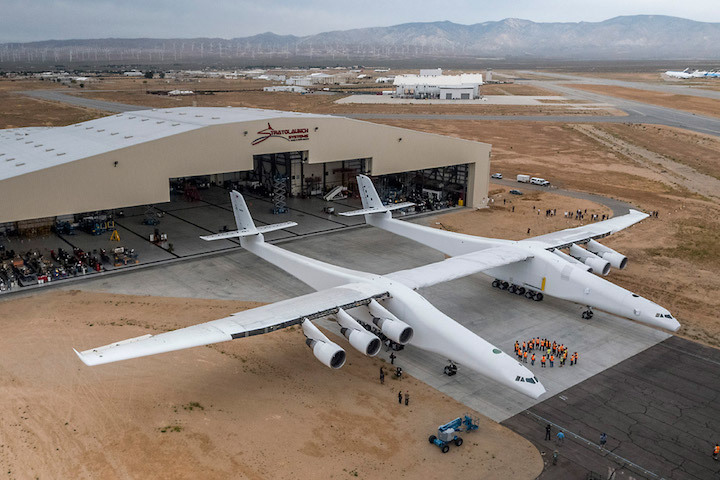
A Scaled employee who did decide to reside in Mojave is Zachary Reeder, a boyishly charming late thirty-year old, hailing from “the boonies of East Texas.” Growing up in the 1980s, Zach eagerly watched the landing of the Voyager flight as a young boy. He recognizes how this watershed event forever altered his career trajectory. Zach later attended Texas A&M where he majored in flight engineering in the shadow of his father. Six days after graduation, Reeder quickly headed west to Mojave where he promptly landed a position as Scaled’s 120th employee.
Calm, energetic and thoughtful, Reeder rapidly rose to become one of Scaled’s top-tier test pilots over the thirteen years he has worked there. Reeder is part of the Stratolaunch flight crew and leads the wing design team. Now considered a “company statesman”, Zach provides mentorship and guidance for the younger group of engineers and test pilots that are coming on board at Scaled.
Reeder acknowledges how the Rutan brothers served as instrumental figures and values his personal relationship with both men. “Dick is a real good friend, but every time I talk to him it’s just an affirmation of what I realized as a kid; ‘Oh you don’t have to get a boring job and move to the suburbs’.” He goes on to state, “You get to know someone and take their presence for granted, but the fact that we’re buddies and we’ve flown together is a validation of why he was so inspirational to me as a kid.” Burt, too, phones Zach once a month to check in.
Of the 600 Scaled employees, Reeder comments that “I would say probably less than 50 live in Mojave. Only a couple of the engineers live here but most of the fabricators that live here [also] grew up here. Almost everyone lives somewhere else, which I philosophically find really inconsistent and that’s part of the reason we tough it out here.”
Rather than moving to nearby Tehachapi or Lancaster, Zach and his wife purchased an historic adobe church in town that they’ve been slowly fixing up. Having started a family, they’ve made a conscious decision to stay put in Mojave for the long term while finding ways to contribute to their community. For instance, on the day Zach was interviewed, he was busy setting up their home for a live house concert planned for later that evening.
As for the town’s constant employment turnovers, Reeder has witnessed this firsthand. “The experience-per-lifestyle slope is pretty steep here, so for a lot of people, once they have these highly-specialized prototyping skills along with enough experience to get a good paying job, we lose people to more attractive startups elsewhere like SpaceX.” He goes on to state, “Mojave is sort of like the Xerox PARC of aviation development — there’s a constant turnover of people that show up, get some experience and put their name on some ridiculous-looking airplane project before they go off and do something more reasonable with their lives.”
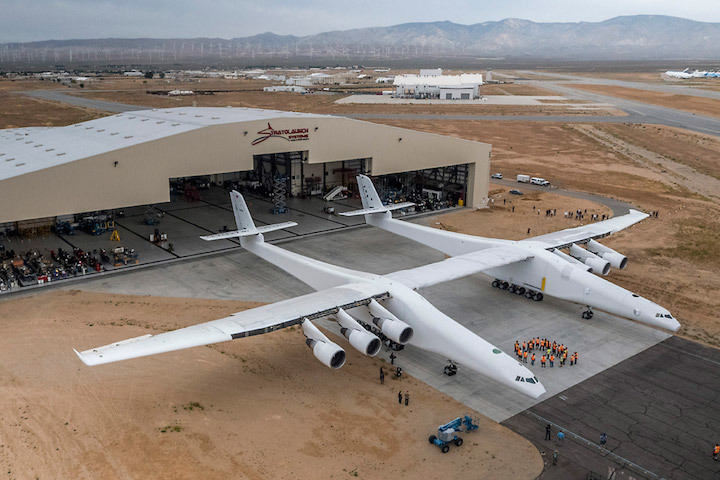
Paul Allen's Stratolaunch, the world's largest plane to date. | Courtesy of Stratolaunch Systems
Reeder anticipates that he and his Scaled colleagues can offer more than just building successfully innovative spacecraft — that they can offer “confidence and problem-solving” to the world stage. “There’s a misconception that we are able to do what we do out here because we have some body of knowledge that’s not accessible. We have no idea how to build the world’s largest plane.[xiii] We have to figure it out.” And if they do, they’ll have something far broader, creative and inspirational to share with the rest of the world.
Still, the commercial, civilian-driven astronautics industry, centered at Mojave, has suffered its share of significant setbacks that have resulted in fatal casualties.
On July 26, 2007, three Scaled employees were killed and three injured when a tank of nitrous oxide exploded and destroyed a test stand during a rocket propulsion test run. Then, on Halloween, 2014, the Virgin Galactic/Scaled team suffered a highly-publicized aerial disaster above the Mojave Desert when the test flight of their two pilot/six-passenger VSS Enterprise, (a version of SpaceShipTwo) failed and crashed, killing co-pilot Michael Alsbury and seriously wounding co-pilot Peter Siebold, who miraculously survived the ordeal after being ejected from the aircraft. National Transportation Safety Board (NTSB) investigators determined the following year that the accident was due to pilot error when Alsbury prematurely unlocked the plane’s re-entry feathering stabilization system after the craft had separated from the mothership. Eleven seconds later, the VSS Enterprise violently broke apart.[xiv] NTSB’s Chairman Christopher Hart would later criticize the spacecraft’s designers for insufficient safety protocols, highlighting their “failure to consider and protect against the possibility that a single human error could result in a catastrophic hazard to the SpaceShipTwo vehicle.”[xv] The spacecraft’s engineers have since developed a color-coded fail-safe inhibitor along with revised flight operator training protocols that would prevent the pilot from engaging the feathering system too early. After the accident, Virgin Galactic took over all aspects of building and testing SpaceShipTwo.[xvi]
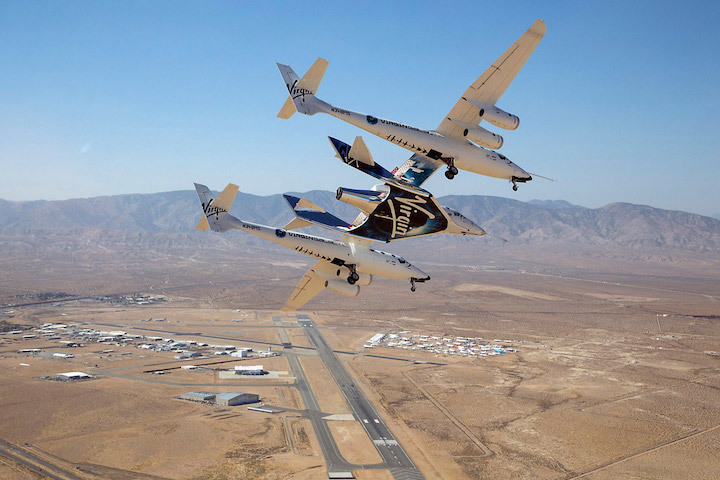
SpaceShipTwo carried by its mothership high above the Mojave Air & Space Port. | Mark Greenburg/Virgin Galactic
Of late, pilots Mark “Forger” Stucky and Rick “CJ” Sturckow completed Virgin Galactic’s fourth successful flight test of VSS Unity when it entered the mesosphere in the early morning of December 13, 2018. Traveling at Mach 2.9, this re-engineered version of SpaceShipTwo reached an altitude of 51.4 miles above earth — just a hair above the mark that is largely considered to be the edge of space. Virgin Galactic and their two pilots can now claim bragging rights to space. As Virgin’s commercial flights finally commence, passengers who’ve forked over a hefty $200,000 to $250,000 apiece, will be propelled to this 50-mile-plus height to witness the sublime curvature of Earth while experiencing a few fleeting moments of zero-g weightlessness amid a blanket of stars. So far, Virgin Galactic has 600 aspiring astronauts signed up for future suborbital flights. However, Branson insists that he will be its first passenger to fly and that their commercial passenger flights will be underway by 2020 if not sooner.[xvii]
Beyond Virgin Galactic’s lofty ambition to get paying customers into space within two years, the company has plans for future facilities at five possible locations worldwide within the next decade starting with the 18,000-acre Spaceport America sited near Truth or Consequences, New Mexico. This controversial endeavor pitched to Branson by former New Mexico governor Bill Richardson in 2007 has already received $200 million in taxpayer dollars for facility development and construction. Richardson secured public funding of the project from New Mexicans by promising 5,000 new jobs and up to $1 billion in new revenue — both of which have yet to materialize. The company will use the Spaceport as its operational headquarters when commercial spaceflights begin but CEO George Whitesides insists that spacecraft and support vehicles will continue to be manufactured in Mojave stating, “Mojave, California is actually the only place in the world where you can design a spaceship, build that spaceship, test that spaceship, and then fly that spaceship into space. I really think it’s the only place.”
Although it seems that Mojave will remain home base for dedicated aerospace entrepreneurial risk takers, competition remains fierce between this exclusive club of aerospace billionaires who are each vying to get their paying customers into space first.[xviii]The stakes are high, too, for the various state officials hustling them to set up shop in their backyards. For instance, Amazon founder Jeff Bezos of Blue Origin and Elon Musk of SpaceX, have staked R&D and launch sites outside of Mojave, California. Bezos’ Blue Origin is headquartered in Kent, Washington, with manufacturing in Alabama and Florida.[xix] Blue Origin’s suborbital commercial launching site, located near the town of Van Horn in West Texas, was selected to launch their curiously-shaped[xx] reusable spacecraft, New Shepard, that both takes off and lands vertically, and will eventually propel up to six paying passengers above the Karman Line during a fully autonomous 11-minute roundtrip flight.
Musk, in turn, leased NASA’s Kennedy Space Center to successfully launch his 230-foot-tall Falcon Heavy rocket from this “multi-user spaceport” on February 6, 2018.[xxi] SpaceX signed a twenty-year agreement to use the Florida space center for future test launching operations. Musk is also developing a private location near Brownsville, Texas that will be used exclusively to launch SpaceX’s BFR (Big Falcon Rocket) with which he hopes to colonize Mars in his effort to establish a “fallback planet” for humankind.[xxii] Without a doubt these enterprises have the potential to translate into lucrative investment profits—a 2017 Bank of America/Merrill Lynch report estimates that this burgeoning commercial aerospace industry could potentially generate $2.7 trillion within 30 years although a similar report, by Morgan Stanley, lists only $1.1 trillion by 2040 in comparison.[xxiii]
Although the general public may see these mega-wealthy “space barons” as primarily interested in bankrolling their own childhood space fantasies, Bezos, in contrast, has commented that this initial stage promoting “space travel and rocket launches, through tourism and entertainment” is not to provide “high-priced amusement rides for the wealthy.” [xxiv] Rather, his longstanding vision, first articulated years ago during his 1982 high school valediction which he gave to fellow students, entails colonizing space in an effort to protect Earth with the idea that we move ecologically damaging industry off the planet leaving it as a gigantic park zoned for “residential and light industrial” use only.[xxv]
Of course, Bezos and his cohort’s collective vision brings up far more questions than it can provide answers for including a plethora of philosophical concerns regarding the moral and ethical implications of space colonization and possible exploitation of worlds beyond our own. As this industry evolves and matures, issues such as these will need to be openly addressed and debated within a public forum well beyond the corporate boardroom.
But for now, their goal is to safely and consistently reach the boundaries of space until these vehicles are unassailably foolproof to fly civilians as planned. Time will tell whether or not Mojave, California remains suspended in the center of this exhilarating era of commercialized aerospace travel and ingenuity, extraterrestrial exploration and future multi-planetary colonization. After all, this is the place where the elusive “demon of the air” was finally vanquished so it appears that Mojave’s prospects remain endless.
Research and interviews for this dispatch conducted by Daniel Housman. Audio interviews of Dick Rutan and Zachary Reeder conducted by Kim Stringfellow. Sound design by Tim Halbur. Scott Buckley provided music for the Dick Rutan audio track. Image of Virgin Galactic’s VSS UnitySpaceShipTwo launched on December 13, 2018 courtesy of Virgin Galactic under their editorial fair use license.
Daniel Housman and Kim Stringfellow would like to thank the following individuals who graciously contributed to this dispatch including Bill Deaver, Karina Drees, Cathy Hansen, Ted Hodgkinson, Dan Kreigh, Dezso Molnar, Eugene Nemirovsky, Lorelei Oviatt, Zach Reeder, Dick Rutan, George Whitesides and Stu Witt.
Quelle: KCET
